This article contains affiliate links, and any purchases made through those links may result in a small commission.
With such a short growing season, soil thermometers are an integral part of any Northeast gardener's tool kit and can make a difference in the survival rate of seedling transplants and direct seeds. There are many soil thermometers on the market from simple analog thermometers to multi-function thermometers that measure soil ph, moisture, and soil temps. Here's a review of a few of the soil thermometers we have on hand.
When choosing a soil thermometer the basic criteria are cost, display (analog vs digital), shaft length, and number of functions (moisture, ph, temps, etc.). If you're monitoring houseplants, you may want one that reads the moisture level and has a longer shaft. For monitoring cell pack seedlings, you'll need a thermometer with a shorter shaft so the sensor will be set deep enough to get an accurate reading because there's only a few inches of soil. The six- or seven-inch shaft length seems to work for both three-inch cell packs, as well as the outdoor raised beds.
The soil thermometer shown below is made by Luster Leaf and was only $5 at my local garden center. It's a basic glass thermometer wrapped in steel which makes it very sturdy, but the window of glass is very narrow so it can be tough to read. The metal wrapping conducts heat and cold very well so it's accurate, but it takes more time to get to the proper temperature. The stem is about six inches tall but it's thicker than the other thermometers so doesn't work well with small cell packs. Its sturdiness allows it to be used as a dibbler for larger seeds as well as making furrows for smaller seeds such as carrots and radishes. It's too narrow to make a furrow for peas. All in all it's not a bad thermometer for the price and is available on Amazon but it's also widely available at local garden centers.
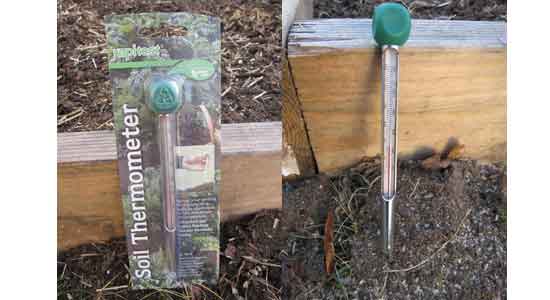
The next soil thermometer shown below is a Luster Leaf model and was $9 on Amazon. Although it has a very wide dial face, the top two-thirds of the dial is imprinted with seed germination temps while the soil temperature readout is condensed along the bottom which makes it tougher to read. Having the seed germination info on hand might be helpful to beginners, but a larger temperature readout would probably be preferrable for many gardeners.
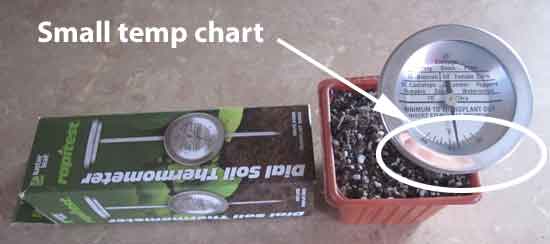
The next soil thermometer shown below is an Acu-Rite model, and was also $9 at Amazon. It has an analog dial face and a seven-inch stem. The thermometer also comes with a sleeve for the stem that has a clip which can attach to a shirt pocket or tool belt, and the thermometer can be calibrated. This thermometer is easier to read than the Luster Leaf, and the stem is slightly thinner which may prevent root damage when inserting it into a container or cell pack.
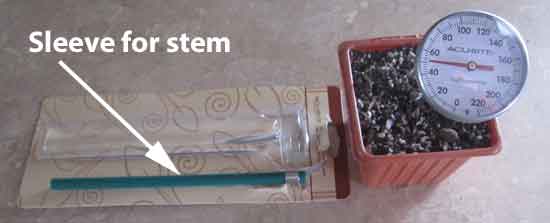
The pic below shows the undersides of the two soil thermometers. Just as with a food thermometer, to calibrate a soil thermometer place it in a glass filled with an icewater slurry and turn the small nut on the underside of the thermometer head until it reads 32°.
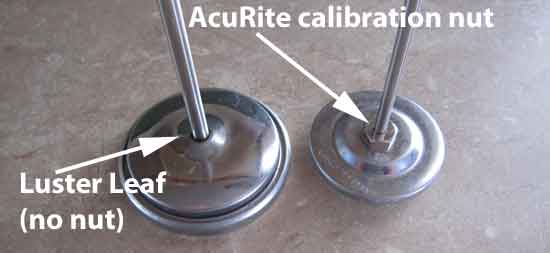
The fourth soil thermometer is a Luster Leaf digital soil thermometer.The thermometer was $15 on Amazon and is the easiest to read because it's digital, but it still needs to be in the soil for about 60 seconds in order to get an accurate reading, so it's not really an instant-read thermometer. The overall length is 9.5 inches with a five-inch shaft. When pulling the thermometer out of the ground pull it up by the shaft because the head can come off, especially if you have clay soil.
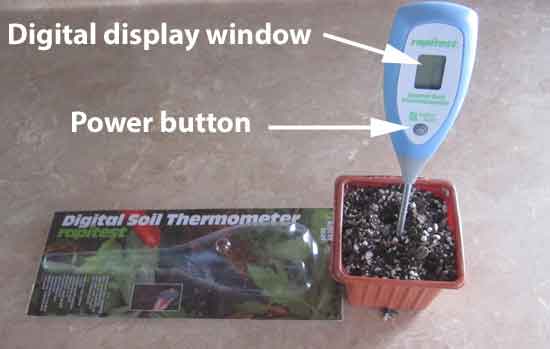
All the soil thermometers shown work well and of the four reviewed here, the Acu-Rite and Luster Leaf digital model (Amazon) were the best buys. The other two work fine, but weren't as good a value. The best soil thermometer doesn't have to be fancy - decide what you need and how much you want to spend and go from there.